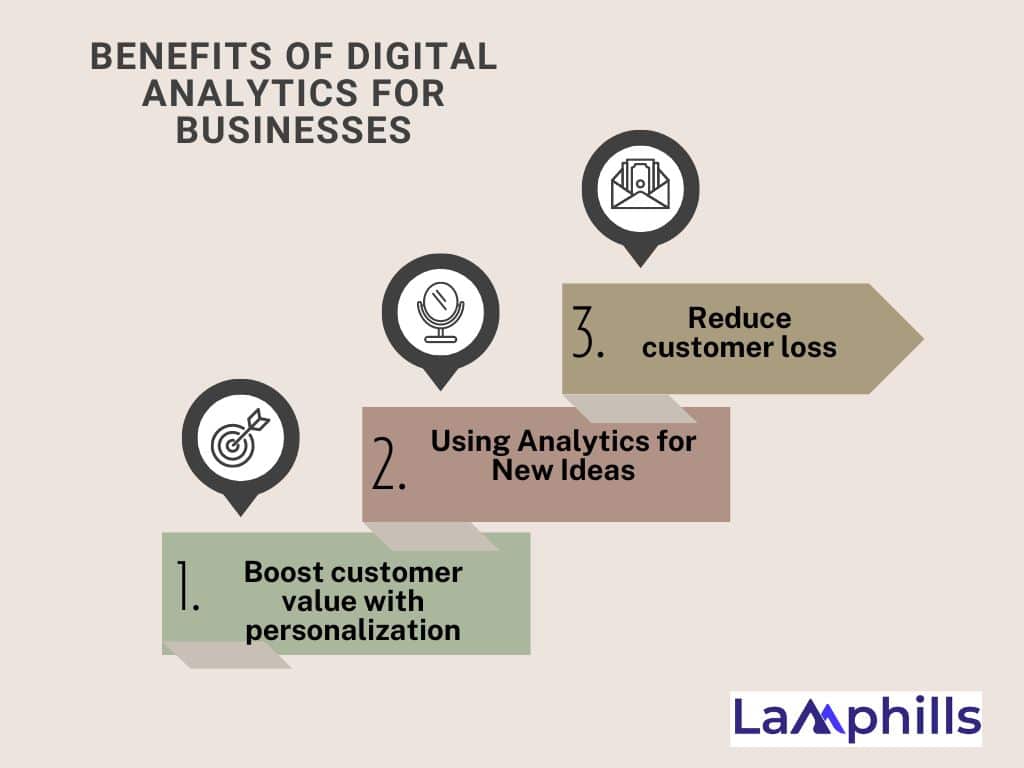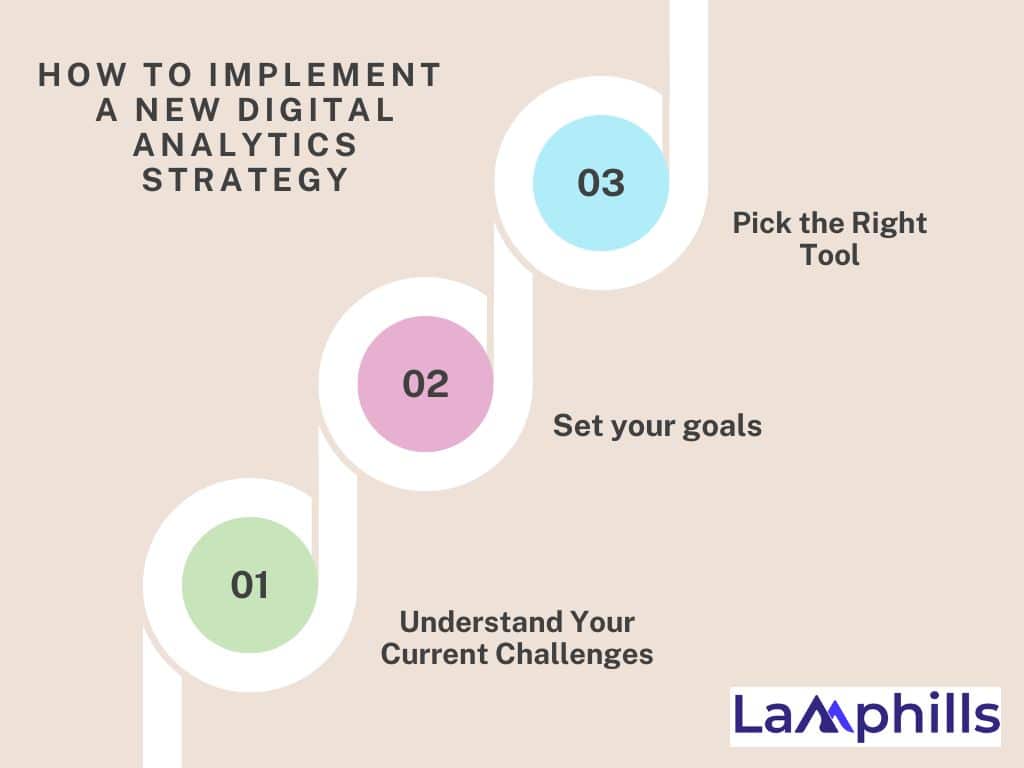Digital analytics tools help us understand how people interact with websites and apps. By collecting data on what visitors click on, how long they stay, and what they like, these tools provide insights that can help improve digital services and make better marketing decisions. In short, they’re like super-smart assistants that make it easier to see what’s working online and what’s not.
Companies like Amazon and Netflix use this information to create features tailored just for you. However, businesses of all sizes can use this data to make better choices. This helps them keep customers, try new things, and get more value from the customers they already have. Digital analytics includes everything from website data to digital marketing and product information.
There are many digital analytics tools, and you need to pick the ones that are right for you. For example, Google Analytics can show you which pages your visitors go to, how long they stay there, and which of your marketing strategies are working best.
However, what works well for one website may not be as effective for another. In this article, we’ll learn about digital analytics and explore various digital analysis tools that you can use to enhance your online presence and optimize user experience. Let’s get started.
Key Points
- Digital analytics involves collecting, analyzing, and understanding data from digital sources like websites, social media, and mobile apps to help businesses make informed decisions.
- Digital analytics unifies data from various sources, like marketing channels and customer interactions, enabling businesses to gain comprehensive insights and make informed decisions.
- By analyzing user behaviour, businesses can tailor their products and marketing efforts to enhance customer loyalty and retention.
- Digital analytics can be categorized into product analytics and marketing analytics.
- Various tools, such as Google Analytics, HotJar, Screaming Frog, Ahrefs, and Hubspot, are used to manage and analyze digital data.
What Is Digital Analytics?
Digital analytics is the process of collecting, analyzing, and understanding data from digital sources like websites, social media, and mobile apps. The main goal is to get insights that can help businesses make better decisions. These decisions might involve improving marketing strategies or making a website easier to use.
In 2015, I had just started my job as a legal assistant at a law firm. One day, during a casual chat with a coworker, I heard about something new to me: digital analytics. I had no idea what it was, but the idea of using data to make better decisions sounded interesting. Little did I know this curiosity would lead me to something that would significantly impact my career. Today, digital analytics isn’t just a part of my job; it’s an essential tool I use to solve problems daily.
As I got more involved in digital marketing and managing social media, I began to understand why digital analytics is so important. It’s not just about looking at numbers on a screen; it’s about understanding that data to make smart decisions that can really make a difference. Whether I was tracking how well a marketing campaign was doing or analyzing website traffic, digital analytics became my guide in the world of online marketing.
From my experience, I’ve learned that digital analytics is like putting together a puzzle. Each piece of data shows a small part of a bigger picture. When all the pieces fit together, they reveal trends and patterns that are crucial for creating effective marketing strategies. It’s the difference between guessing and knowing precisely what needs to be done.
Where is Digital Analytics used?
Ever wondered how Netflix or Amazon suggests shows or products you might like? They use customer data and digital analytics to make these recommendations.
Today, big companies like these are not the only ones that can use data this way. Most businesses have lots of customer data that they can analyze. By looking at how customers use their digital products, marketing and product managers can learn what’s working, what’s not, and what might work in the future.
For example, if a lot of people visit a website but leave quickly, it might mean they didn’t find what they were looking for. Digital analytics tools, such as Google Analytics and Adobe Analytics, help spot these trends. They provide valuable insights that can guide decisions to improve the website and make it more enjoyable for visitors.
Digital analytics comes in two primary forms: product analytics and marketing analytics. In top companies, marketing and product teams work together to achieve their goals.
Digital Product Analytics
Digital product analytics is about gathering and studying data on how people use your product. This information helps you make better decisions about how to improve and refine your product. For example, if you want to make the process of getting new users started smoother, digital analytics can show you where users are losing interest, so you can try out new approaches.
Some key metrics in product analytics include:
- Activation rate: How many users start using your product?
- Retention rate: How many users keep coming back?
- Feature usage: How often do users engage with different features of your product?
Web and digital marketing analytics
Digital marketing analytics is about studying marketing data to make better decisions and get the most out of your marketing budget.
Web analytics, a part of digital marketing analytics, focuses on how well a website is performing. For example, a business might look at how many people are buying products through different marketing channels like email, paid ads, and social media. They’ll then put more effort into the channels that bring in the most sales. They also check how well their website is working by looking at which pages lead to sales and where visitors are leaving the site without making a purchase.
Marketing metrics include:
- Website data includes the number of people visiting your site naturally, the number of pages they view, and the number of pages they visit in one session.
- The cost of getting a new customer.
- The rate at which visitors take the desired action, like making a purchase or signing up.
Where does digital analytics data come from?
Companies usually gather data for digital analytics from several sources and often combine it with data from different sources into one digital analytics platform.
#1. Marketing Channels
The information from your digital marketing efforts gives you important insights into potential customers. For instance:
- Keyword Insights: Looking at the keywords people use to find your site can show new trends in areas you haven’t explored yet. Your pay-per-click (PPC) campaigns offer useful details about what interests potential customers and which messages connect with them best.
- Social Media Data: Your social media stats show which types of content, tone, and messages resonate with both prospects and current customers.
- Website Information: Analyzing the data on your website visitors and their actions helps identify which groups of people are most interested in specific products or features. It also reveals which marketing channels are working best and how well different pages and campaigns are performing.
#2. Product Behavior
Your customers are interacting with your product right now, creating valuable data. How they use your product can show you important details about what works well and what doesn’t. By analyzing this data, you can discover:
- Which features are the most and least popular
- Key actions that lead to conversions
- Areas where users experience difficulties that might cause them to leave
- Similarities among customers who bring in the most value
Digital analytics helps you make informed decisions about your product strategy, so you’re guided by real user behavior rather than guesswork.
#3. Customer interactions
Looking at your internal data helps you understand how long customers stay with you and how valuable they are over time. Your analytics can show patterns, like when customers are likely to upgrade, downgrade, or leave. With this information, you can adjust your marketing efforts to focus on customers who are identified as high-value.
You can find helpful data in various areas, such as:
- Customer complaints
- Account details
- Transaction histories
What are the benefits of digital analytics for businesses?
Before digital analytics, product management and marketing decisions were often made based on gut feelings and past experiences. With more customers active online, a lot of information is available about their behaviours.

By bringing all your analytics data together in one place, you can look at the entire user journey, from the first ad they see to how long they stay with your brand. A unified digital analytics platform helps you get valuable insights that can benefit your business in many ways:
#1. Boost customer value with personalization.
Many businesses are now customizing their products and marketing efforts for different customer groups. Personalization enhances the customer experience, leading to increased loyalty and repeat business.
To personalize effectively, you need to use analytics. A good analytics tool can predict what customers might want or need next by looking at their past purchases, profiles, and behaviour. Companies can use this information to create tailored messages and experiences. For example, personalized product recommendations not only improve the customer experience but also create great opportunities for upselling and cross-selling.
#2. Using Analytics for New Ideas
Analytics isn’t just for solving problems with your product—it’s also useful for discovering new ways to make money, add features, or create strategies. For example, you might find that a lot of people are using your playlist-building feature. This insight could lead to adding more features or even creating a new product.
You can also experiment with product marketing. Let’s say you notice that customers who build playlists are ten times less likely to stop using your service in their first year. You could then send an email campaign to customers who aren’t using the playlist feature, promoting it and providing a direct link to it.
#3. Reduce customer loss
Digital analytics can help you match your product’s performance with what you promised in your marketing. For example, if you advertise a smooth music streaming experience, but customers leave before downloading their first song, your analytics can show you where things are going wrong.
To lower the rate of customer loss, you can use digital analytics to fine-tune your marketing efforts. The data will show you the characteristics and behaviours of your most loyal customers. Once you identify which customers spend the most and stay the longest, you can design marketing campaigns to attract similar people who are likely to stick around and bring long-term value to your product.
Examples of Digital Analytics in Action
One of the most memorable projects I worked on was a digital marketing campaign for a local café. The café had great products but was struggling to attract customers. My colleague Sam and I decided to use data to solve this problem. We started by using Google Analytics to track the café’s website traffic.
We noticed that although many people were visiting the site, many were leaving quickly. This was a sign that the website needed some improvement. After looking at the data, we found that the homepage was too cluttered and slow to load. Based on these findings, we simplified the design, optimized the images, and made it easier to navigate.
The result? The number of people leaving the site quickly dropped by 40%, and the café saw a big increase in online orders. This experience showed me how powerful digital analytics can be. It’s not just about collecting data; it’s about using that data to make real improvements that positively affect the business.
What to Look for in a Digital Analytics Platform
Turning a large amount of information into a useful plan can be challenging. Big companies like Slack handle data from millions of customers every day, each with its own unique details. Even smaller businesses struggle to understand the data from thousands of potential and current customers. To make sense of all this information and gain value from it, you need a good digital analytics platform.
Here are the key features to look for in a digital analytics solution:
#1. Data unification
A good analytics tool helps you connect all your digital data sources in one place. Customer data has become too complex for old methods like spreadsheets and basic databases.
Even if you could somehow manually enter all the important data into a spreadsheet or database, sorting and analyzing it could take you days or even weeks. While there are tools that let you analyze your web, product, and internal data separately, the real strength of analytics is in bringing all your data together.
#2. Key Features
An analytics platform that only stores data is just a fancy database. The right digital analytics platform should let you:
- Run tests like A/B testing
- Follow customer journeys
- Use your data to make predictions and suggestions
- Group users based on past and expected actions
- Identify the best time to focus on keeping customers and adding value.
#3. Growth and Ease of Access
Growing businesses need platforms that can manage more data as they expand. Older analytics systems often become slow and complicated when new features are added to handle more users and data. It’s crucial to have a digital analytics tool that can grow with your business and is simple to use.
Choosing the right digital analytics tool can really help your business understand and improve how people interact with your website or app. But with so many tools out there, it can be tricky to pick the best one for your needs. Here’s a checklist to guide you through.
This checklist will guide you through the key points to consider, ensuring you choose a tool that fits your business goals, integrates well with your current systems, and is easy to use. Let’s dive into the details to make sure you get the most out of your digital analytics efforts.
Examples of Digital Analytics Tools
Many digital analytics tools can help businesses manage their customer data. The right tool for your company will depend on how you want to use the data. Over the years, I’ve tried out some of these tools, each with its strengths. Here are some of the best ones that have consistently worked well for me:
#1. Google Analytics
Google Analytics is the go-to tool for digital analytics. I don’t think digital analytics would be what it is today without Google Analytics.
Google Analytics changed how we view websites. In the past, websites were all about design, but as the Internet evolved, they shifted to focus more on marketing performance.
User behaviour became important because Google Analytics tracks data from the user’s perspective, and it’s the best tool in the industry for this. Some even say it revolutionized marketing by introducing new ways of thinking.
It provides data like page views, where users drop off, the most viewed pages, user location, product performance (with Enhanced E-commerce), form submissions, user flow visualization, mobile devices, operating systems, and much more.
I’ve tried Adobe Analytics, and while it serves a similar purpose, I wouldn’t recommend it. The user interface is difficult to navigate, and the dashboard setup is confusing. Plus, I don’t think it’s free. Google Analytics is still the best choice for any business, big or small, in any industry. If you need to track website performance, GA is a solid option.
Google Analytics is a great free tool to start with in digital analytics. It becomes even more powerful when paired with deeper user tracking, which brings us to the next tool.
#2. Hotjar
HotJar is one of my favorite tools for understanding users and gathering feedback. It’s widely used in the industry for good reason. HotJar provides heatmaps, user recordings, and tools for polls and surveys. It’s beneficial for website owners who want to add context to the data they get from Google Analytics.
The heatmaps in HotJar show where users click and where they hover their mouse on a webpage. This visual data offers valuable insights into user behavior.
With the visitor recording feature, you can see exactly what specific users do on your website. It can record users’ actions as they browse, and you can set it to run under certain conditions, like on mobile devices only.
HotJar also includes polls and surveys, which help scale up customer feedback. This feature is particularly useful for those involved in market or user research. After collecting data, HotJar automatically organizes responses or even turns them into a word cloud.
The best part? HotJar has a free version that’s enough to showcase its value, even though it comes with some limitations. The first paid plan starts at $30, which I believe is reasonable considering the potential return if used effectively.
While Lucky Orange is a cheaper alternative, I wouldn’t recommend it. Though it has some strengths like dynamic heatmaps and affordable pricing, it lacks in important areas like visitor recording filters and has a clunky interface with limited poll options. Another drawback is its monthly session limit and short data storage period of only 30 days, meaning data is deleted every month.
I haven’t tried other tools like Mouseflow, FullStory, or Qualaroo yet, but HotJar offers great value for its price.
#3. Screaming Frog
Screaming Frog is a must-have tool for technical SEO audits. It scans websites to find SEO problems that might hurt your search rankings. It checks metadata, title tags, broken pages (404 errors), the length of meta descriptions, internal and external links, and headers (H1/H2). These are important to watch when making changes to a website.
The tool is free for up to 500 URLs per scan. However, if you need more, it costs £150 per year. Though the price is high, the features it offers make it worth it.
Screaming Frog’s strength is in its ability to pull in data from Google Analytics and Google Search Console through its API connector. This feature is great because it combines different data sources to give you a full picture of your website’s SEO potential.
One of the tools Screaming Frog connects with is Ahrefs, a popular backlinking tool.
#5. Ahrefs
Ahrefs is an essential website tool because it covers both on-page and off-page SEO. It starts at $99, but it’s worth the investment if you need strong SEO results.
Unlike Screaming Frog, Ahrefs has its own technical SEO audit tool and in-depth research data useful for digital marketing. Content marketers will find its content idea explorer very helpful.
Ahrefs can scan a website to show its top-performing pages and compare content gaps between different sites, which is great for competitor analysis or industry comparisons. It also has a keywords explorer tool, allowing SEO experts to conduct thorough keyword research.
SEMRush is another tool worth mentioning. I’ve used SEMRush in my career, but it’s hard to say which is better. I use Ahrefs more because of its wide range of features.
In my experience, SEMRush focuses more on pay-per-click data, while Ahrefs is better for SEO. Both tools are valuable, but if I had to choose one, I’d go with Ahrefs.
#6. Hubspot
Hubspot is a popular tool among content marketers, especially for managing CRM leads. Besides capturing leads, Hubspot also provides marketing analytics and dashboard features. It easily integrates with other business tools, making it simple to track customer data throughout the sales process.
Hubspot’s easy-to-use interface helps businesses create and manage campaigns smoothly, leading to an efficient marketing process. The platform offers detailed data analytics and insights, allowing businesses to make smart decisions and grow effectively.
How to implement a new digital analytics strategy

To make the most out of your digital data, there are a few important steps to follow.
#1. Understand Your Current Challenges
If your business already has a digital analytics strategy, there’s likely a reason you want to improve it. Your old system may prevent you from making informed predictions or offering suggestions. Perhaps the A/B testing features are not up to par. Some businesses might start collecting and analyzing their data for the first time.
#2. Set your goals
List what you want to achieve with a digital strategy. Common goals include:
- Creating new products and features
- Tailoring the customer experience
- Finding and fixing issues to reduce customer loss
- Improving the process of getting new customers started
#3. Pick the Right Tool
Not all products will meet the goals you’ve set. Many digital analytics tools offer demos, webinars, or free trials to show how they can help you succeed.
For example, Google Analytics offers free tutorials and hands-on sessions that allow you to explore its features directly. Since digital analytics plays a big role in your business’s success, it’s important to research and choose the right solution. Check out our guide on buying a digital analytics platform.
Conclusion
Looking back, I realize that digital analytics is more than just a tool; it’s a way of thinking. It’s about curiosity, asking the right questions, and looking for data-driven answers. Whether you’re experienced in marketing or just starting, embracing digital analytics can help you make smarter decisions, get better results, and succeed.
Before long, the difference between businesses using digital analytics and those that don’t will disappear. Companies that are slow to adopt will either switch to an analytics-based approach or be overtaken by those that already have. Get ahead by choosing the right digital analytics platform now.
Answers to FAQs.
What is a digital analytics tool?
A digital analytics tool helps organizations gather, measure, and study data, which can be numbers or descriptions. Companies use this information to improve their business activities and create a better online experience.
What is the difference between data analytics and digital analytics?
Digital analytics focuses on understanding and improving a business’s online presence, helping it maximize its digital strategy. On the other hand, data analytics looks at a wider range of information, including online and offline sources like databases, sensors, and text documents.
What are the 4 types of digital analytics?
Digital analytics can be divided into four main types: descriptive, diagnostic, predictive, and prescriptive. Each helps your business understand different aspects of your data and shows you how to use that information to achieve your business goals.
What is an example of digital analytics?
Here are some examples of digital analytics and the things you can measure: Website traffic: how many pages are viewed, the number of unique visitors, clicks, exit rate, bounce rate, and time spent on a page. Sessions: total visits to the site.”
What do digital analysts do?
A digital analyst collects and organizes all data related to a company’s online activities. Every day, they create reports, analyze data, look at dashboards, and assess the number of people visiting the website. They use CRM software and other tools to help with their data analysis.
Who uses digital analytics?
Businesses use digital analytics to understand what customers need, prevent them from leaving, and maximize the value of their existing customers. A good digital analytics tool, like Amplitude, is essential for any company that wants to gain valuable insights from its data.
Similar Articles
Top Free Sentiment Analysis Tools For Market Research Strategy
18 Best AI Marketing Tools To Get Ahead in 2024 + Real-Life Examples.
Best AI Video Editing Tools to Improve Your Video Quality ( Free + Paid )






